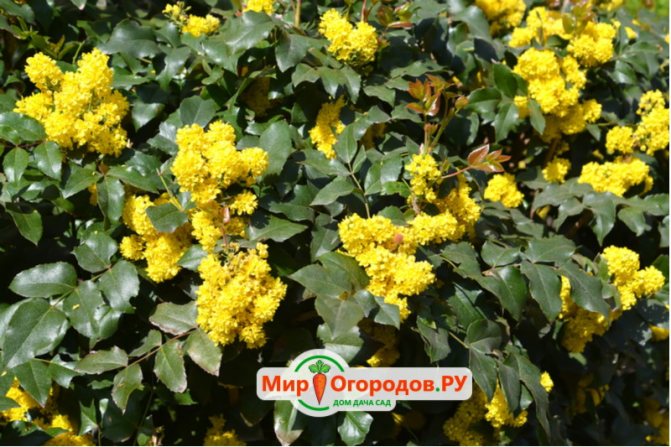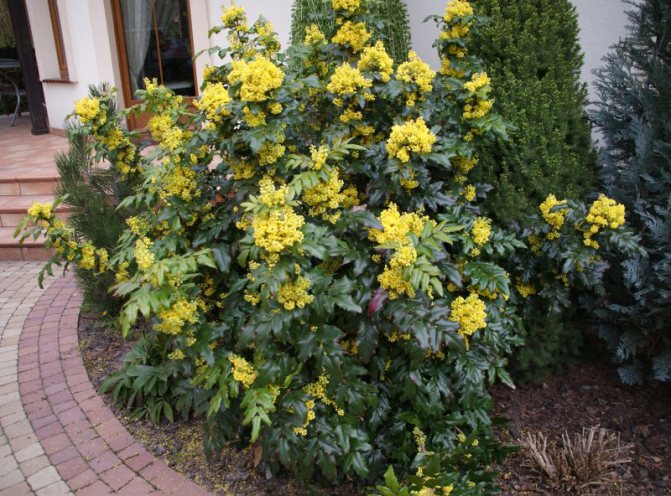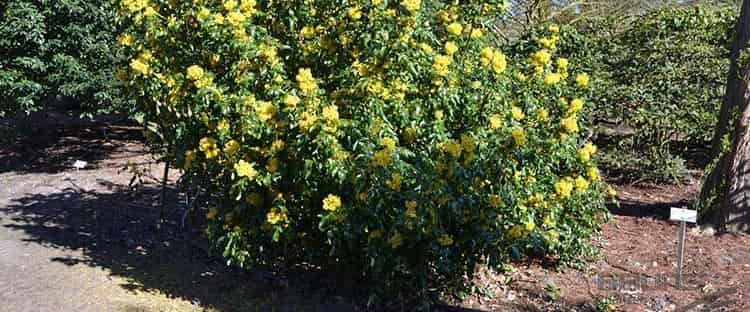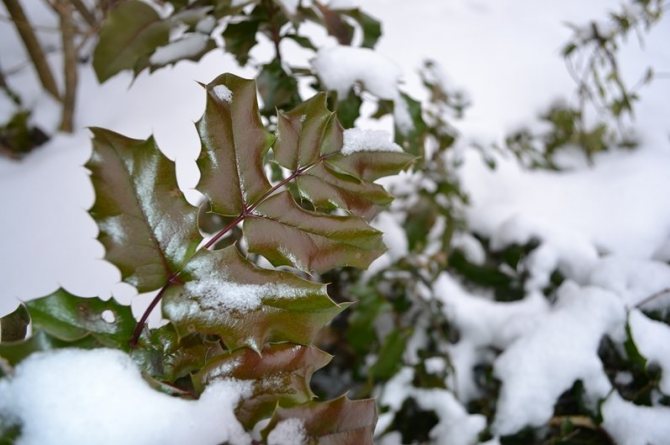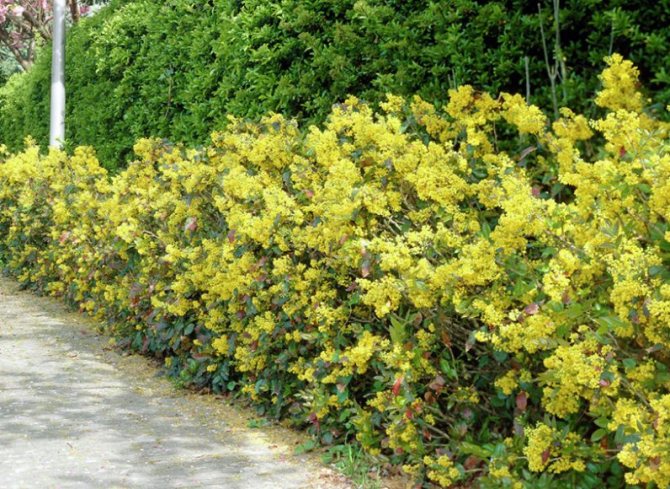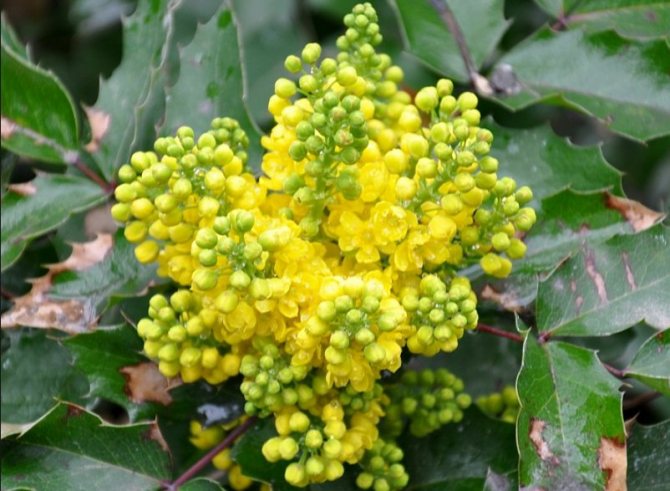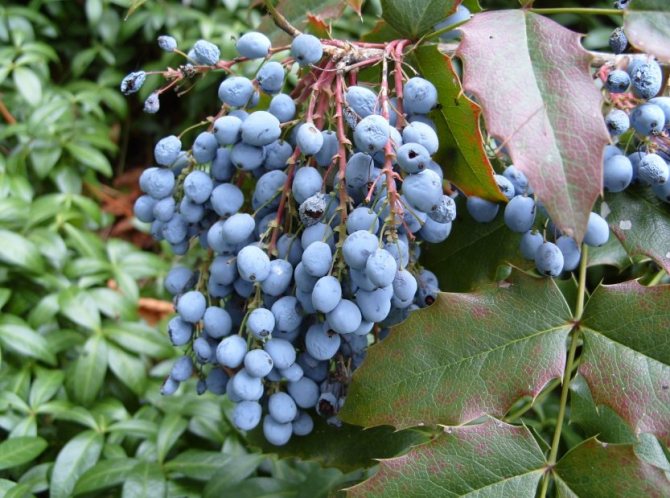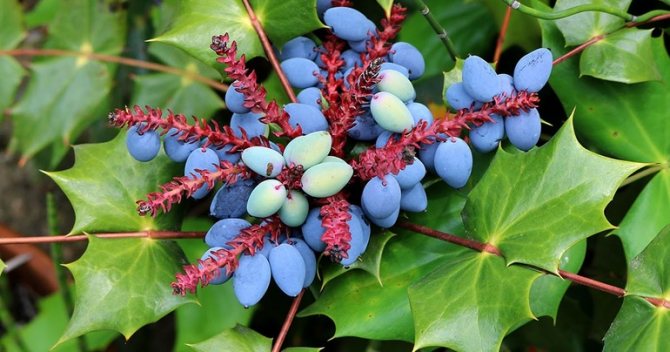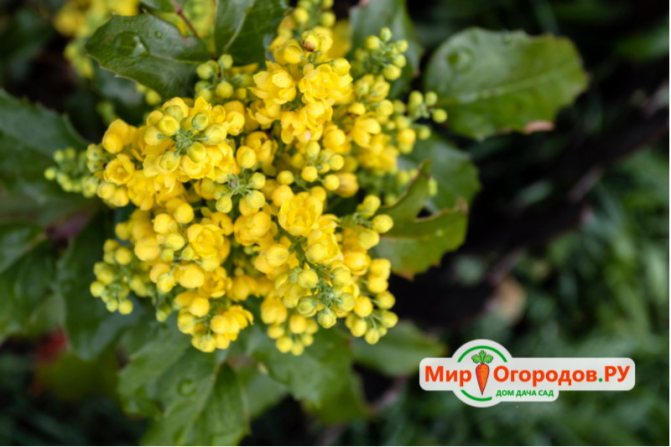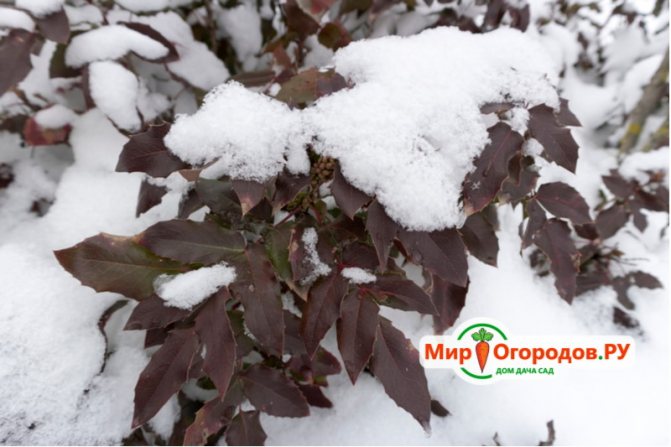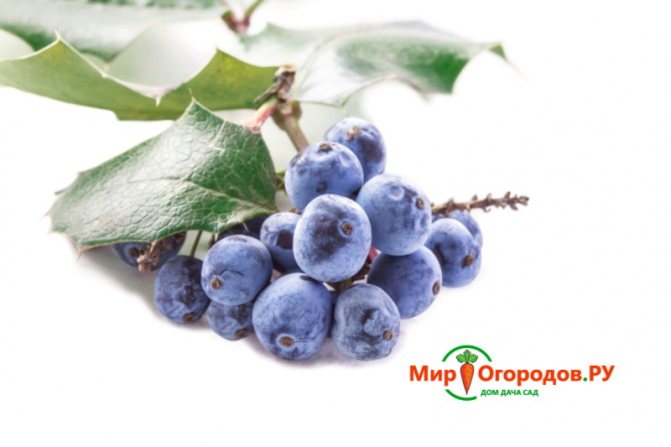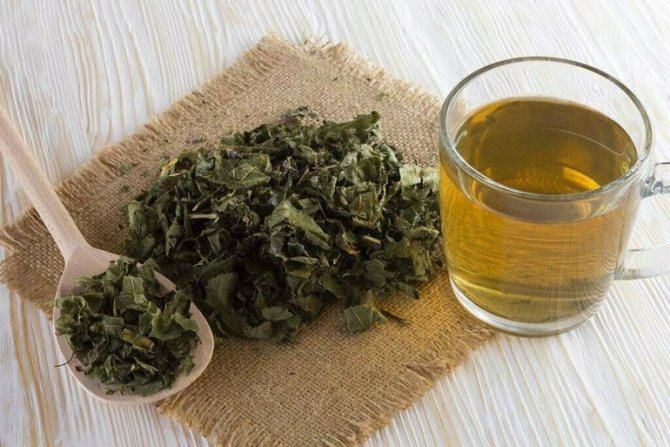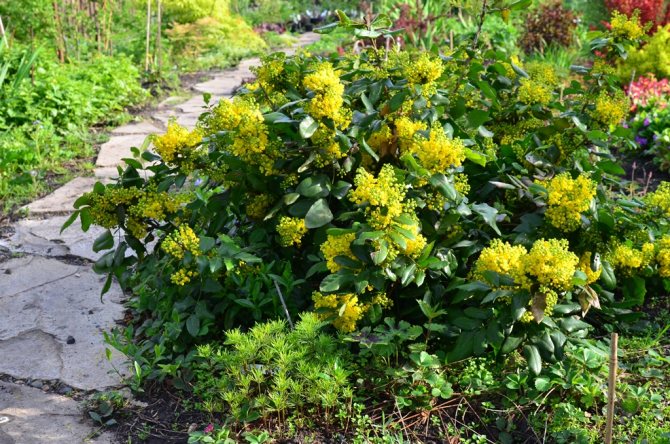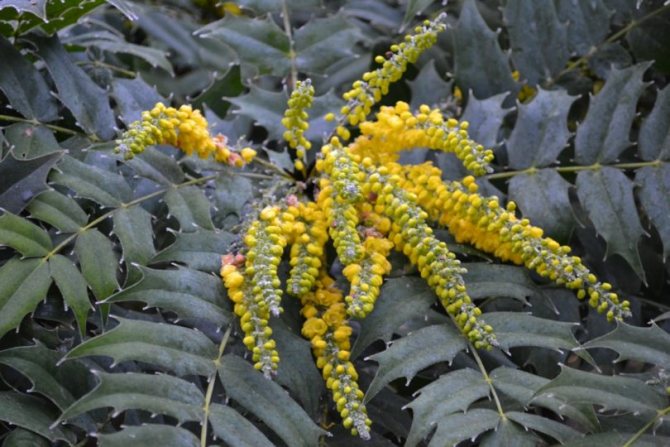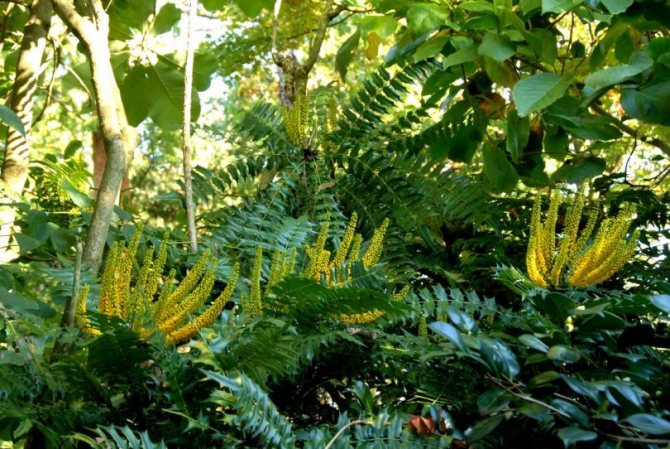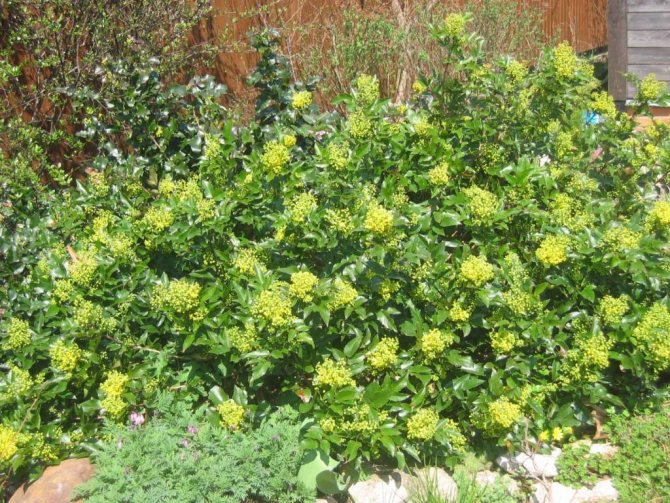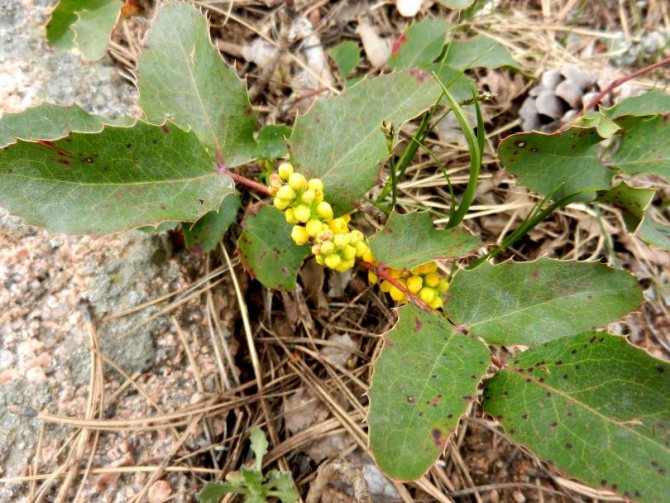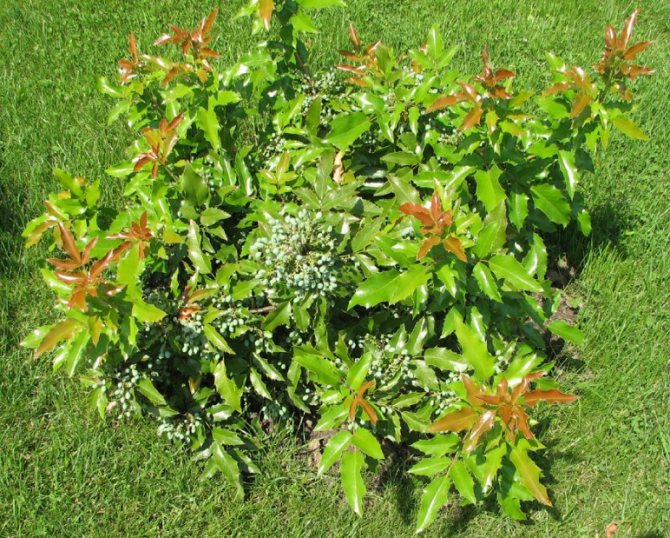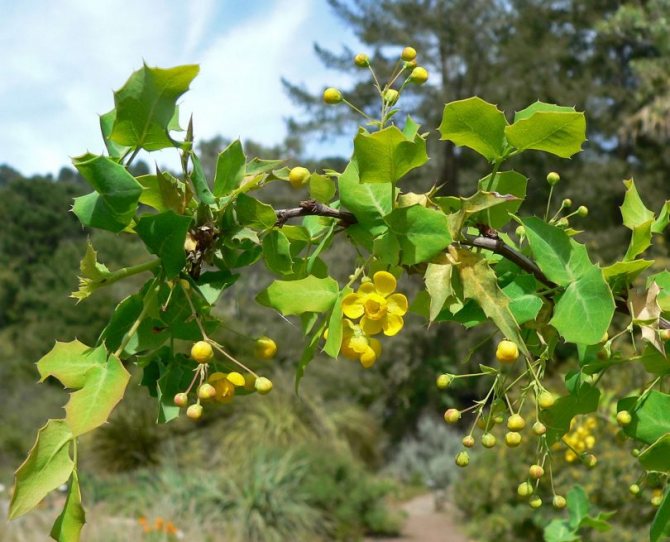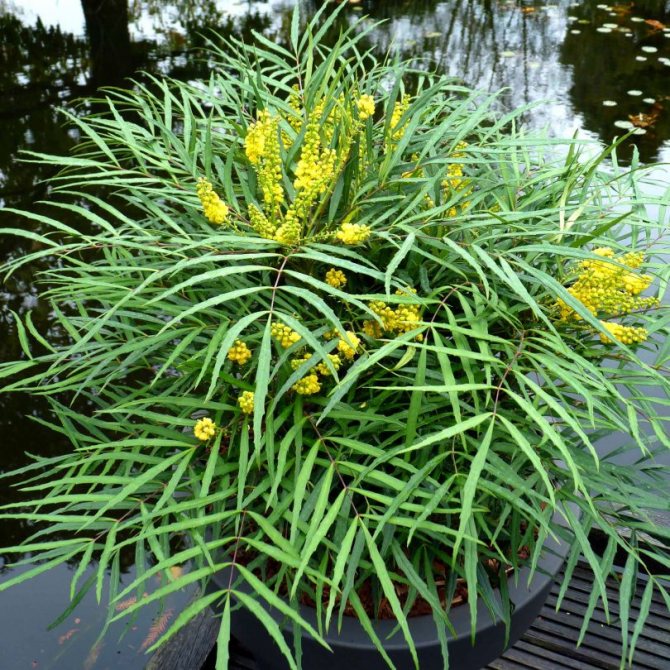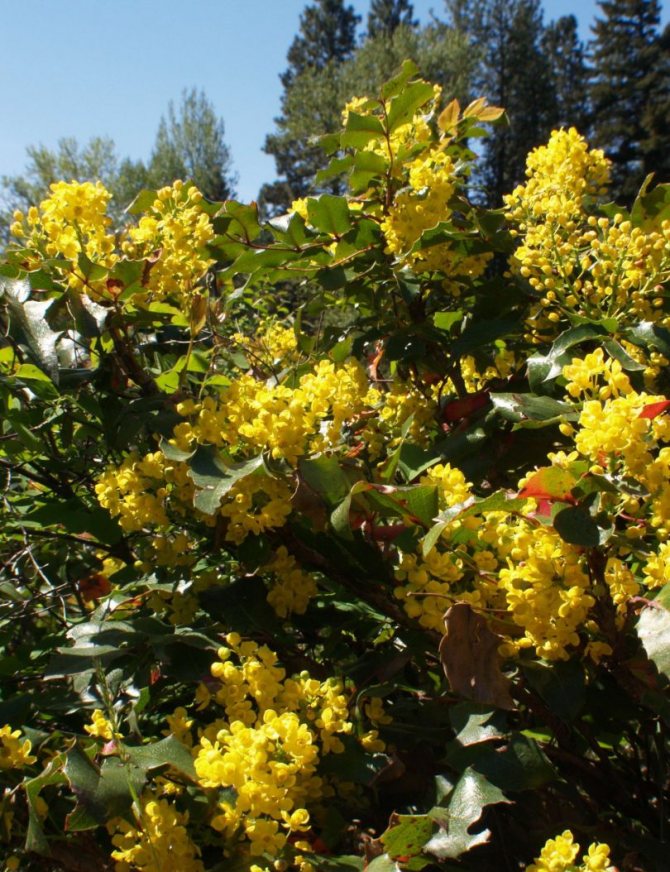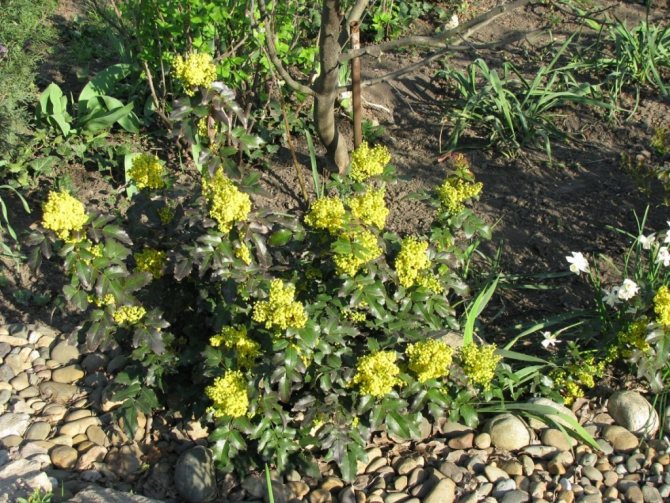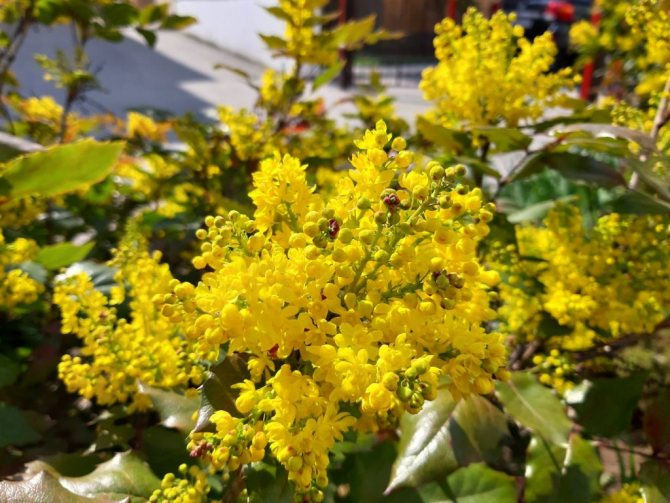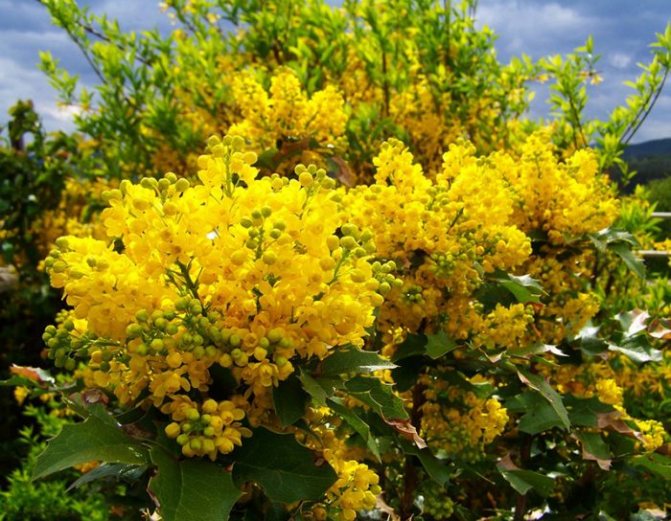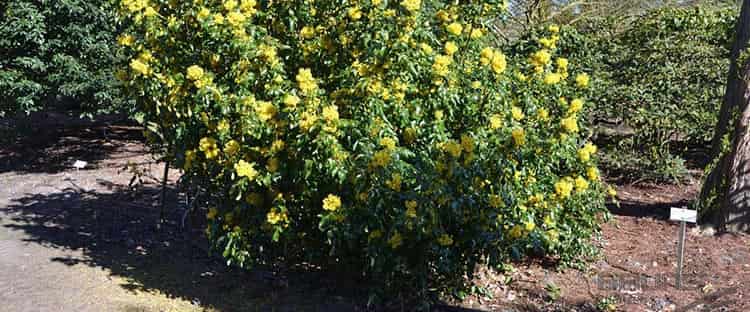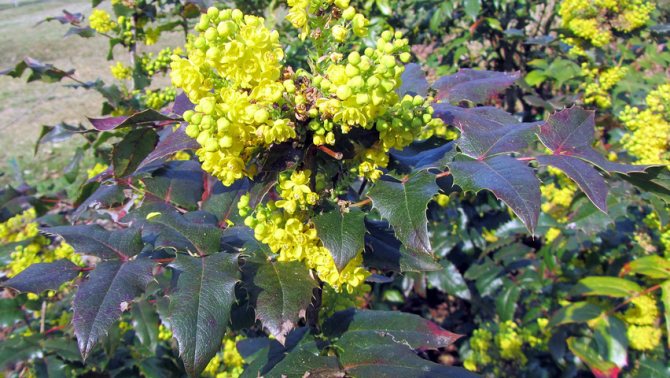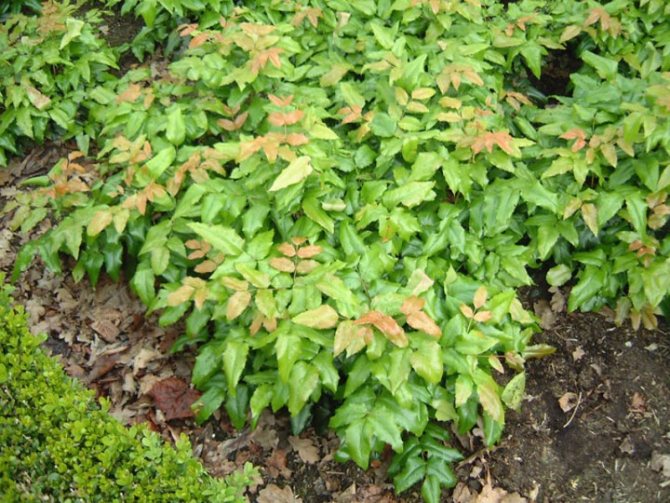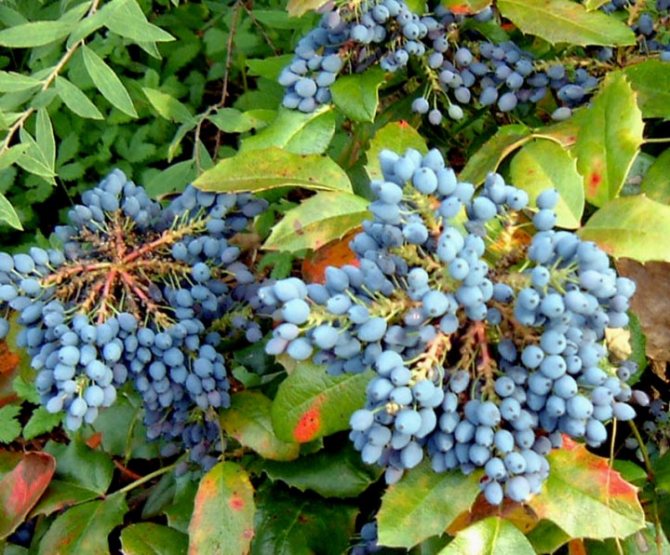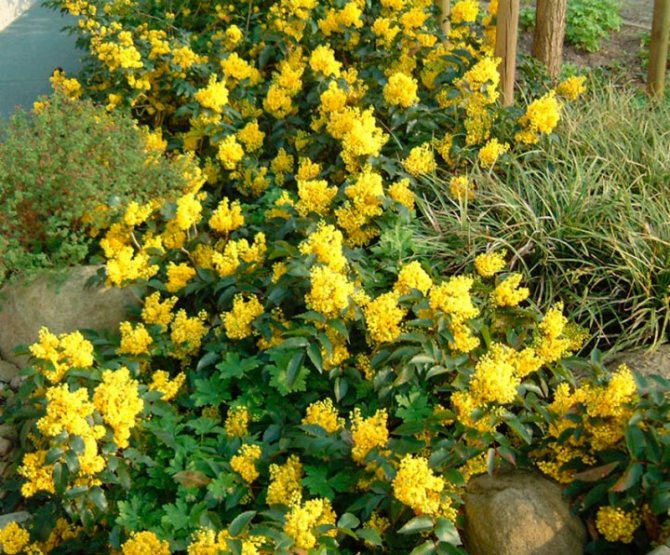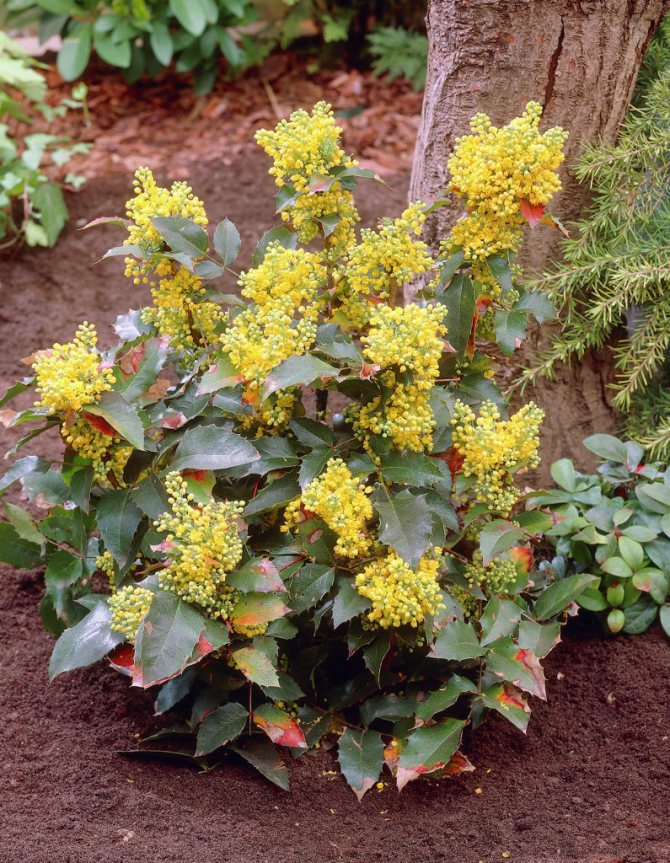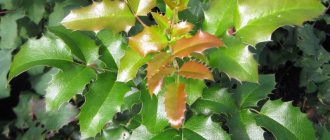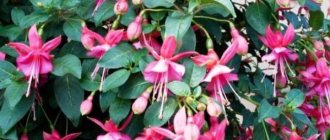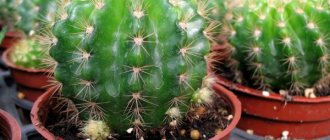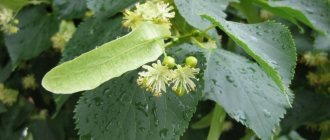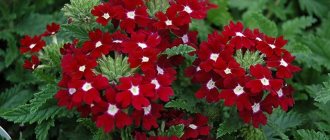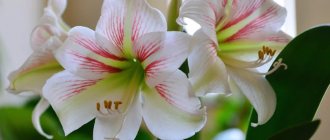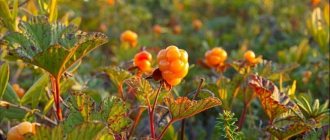The composition and benefits of the plant

Mahonia fruits benefit the body due to their vitamin C content and high concentration of alkaloids. Among them, berberine is especially important. A lot of valuable substances are fraught with bark and rhizome of the bush. In addition to vitamin C, they contain tannins, a lot of organic acids. Regular consumption of Mahonia berries helps to cleanse the blood. The fruits of the plant are added to wines to improve their color, and are also used for baking.
Mahonia berries are a good choleretic agent.
The medicinal properties of the berries of Mahonia holly lie in the peel. It contains many biologically active components and minerals such as:
- sodium;
- copper;
- manganese;
- zinc.
Homeopaths practice treatment with the fruit of the plant for various skin diseases, especially psoriasis.


The roots of an evergreen shrub contain many bitter substances called alkaloids. The most important among them is berberine, which can improve the functioning of the digestive tract.
Fruit extract contains many antioxidants that block the harmful effects of free radicals on cells.
Eating berries:
- softens the stool and facilitates the bowel movement;
- is a prophylaxis against constipation;
- fights diseases of the gallbladder;
- heals hemorrhoids.
The rhizomes of Mahonia holly are no less valuable raw materials. An extract is obtained from it, which contains ascorbic acid, tannins, alkaloids, acids of organic origin.
Many people use infusion with holly mahonia in order to increase appetite and restore the body's strength. The extract from the plant regulates metabolism, strengthens the immune system, activates the cardiovascular system, and is able to slow down the aging process.
Contraindications and possible harm
It is impossible to use medicines obtained on the basis of Mahonia holly for a number of pathological conditions and chronic diseases, including chronic diarrhea, hyperacid gastritis and ulcerative condition in diseases of the duodenum.
Preparations based on the root of such a plant are contraindicated for use during pregnancy and breastfeeding. Among other things, use is strictly prohibited in the presence of individual intolerance, expressed in bouts of severe nausea and repeated diarrhea.
Estimate (1 estimates, average: 4,00 out of 5)
Application and collection of berries
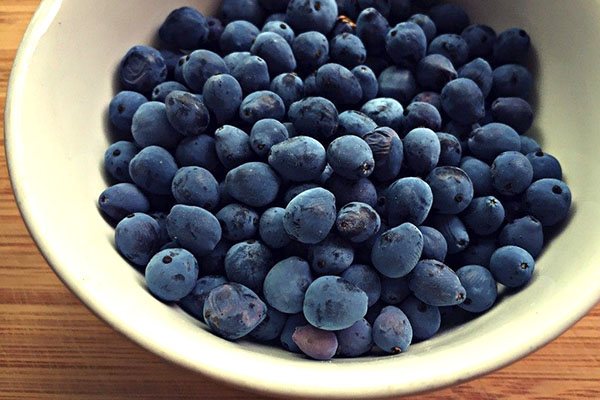

You need to harvest the fruits of Mahonia when they are fully ripe. Ripe berries have an oblong shape. Often they are dark blue, but there are also purple-black. From above they are covered with a bluish bloom. Fruits ripen in August. At the same time, they do not fall off, but stay on the bush for the next 5 months. At the same time, the beneficial properties of Mahonia holly berries and the taste are not lost. They can be stored in a convenient way: dry or grind with sugar.
The bark of magonia contains tannin. This component is the strongest antioxidant. It is able to slow down the aging of cells in the human body.
To taste, the fruits of the bush are a bit like barberry, they are sweet and sour. You can take the berries of Mahonia holly in different forms. They are added to breakfast cereals or fruit salads.Also, various drinks are prepared from the fruits, and also delicious jam. This is a rather exotic berry and its jam is special.
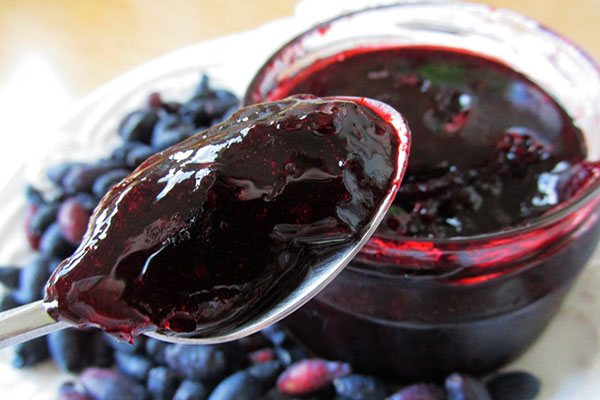

Jam is prepared according to this recipe:
- berries must be sorted out and rinsed thoroughly;
- then blanch in boiling water, no more than 5 minutes;
- fold the fruits in a colander or sieve, let the water drain;
- Pour berries into sugar syrup (its concentration is 60%);
- bring the mixture to a boil over low heat.
It is necessary to cook jam in an enamel bowl. After boiling, remove from heat and leave at room temperature for 10-14 hours to infuse. And only then cook until ready. Closer to the end, you should put citric acid at the rate of 1 liter of jam - 1 g of granules.
Health Benefits of Oregon Grapes
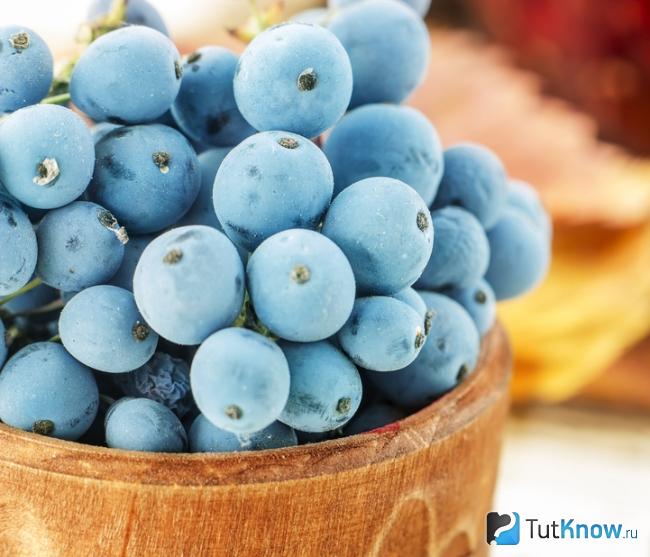

This product is popular among culinary experts in many countries. This is explained by its excellent taste characteristics. It's nice that the benefits of holly mahonia for the human body are quite large.
Regular use of berries in food will help achieve the following health benefits:
- Adjust blood composition
... Powerful hematopoietic function helps to cope with anemia. Blood clotting returns to normal, which, on the one hand, is the prevention of thrombosis, and on the other hand, reduces the risk of blood loss during surgery, periodic female menstruation. The blood is saturated with oxygen, which helps to normalize many important processes in the body. For example, metabolism. Blood circulation improves, the walls of capillaries and blood vessels are strengthened. - Cure skin diseases
... In particular, psoriasis. The strong antibacterial effect helps to cope with many skin diseases, fight infections, fungi, solve the problem of dry skin, peeling, acne, the presence of wen, abscesses, boils. - Coping with digestive problems
... The bitterness in the fruit helps to normalize the production of enzymes necessary for proper digestion of food. They also soften the stool, prevent constipation, prevent neoplasms - benign and malignant, polyposis, cystosis, hemorrhoids. - Support the liver
... The choleretic effect helps to reduce the burden on the liver. It dilutes bile, removes small stones, helps to cope with reflux, sending bile not to the stomach, where it burns the walls, but directly to the intestines - for the final stage of food digestion. - Improve metabolism
... The components of Mahonia fruits help speed up metabolism, remove cholesterol, toxins, heavy metal salts from the blood, and cleanse blood vessels. This, in turn, leads to the normalization of blood pressure, a decrease in body weight, and a general improvement in the body. - Protect the body from tumors
... The presence of antioxidants makes Mahonia an excellent anti-cancer agent. Fighting free radicals, berries protect our body from many neoplasms, including malignant ones. - Boost immunity
... The high content of vitamin C helps to activate the body's defenses, improve immunity, and resist the onslaught of influenza and viral diseases. Especially in the offseason. - Slow down the aging process
... Also, these are such important processes as improving metabolism, normalizing heart function, cleaning blood vessels from cholesterol, losing weight, raising immunity. American barberry will help slow down the aging process, rejuvenate the body both internally and externally, reduce wrinkles, and improve the condition of the skin, hair and nails. - Reduce sugar levels
... For this property, people suffering from diabetes mellitus highly value magonia. A decrease in sugar occurs against the background of an increase in insulin activity.
Mahonia also helps in the treatment of diseases such as hepatitis, blockage of the biliary tract, dysbiosis, cholecystitis, eczema, herpes, rheumatism, gout and others.
However, do not forget that these fruits are not neutral. Therefore, read about the dangers of Mahonia holly for the human body below.
Model Manor
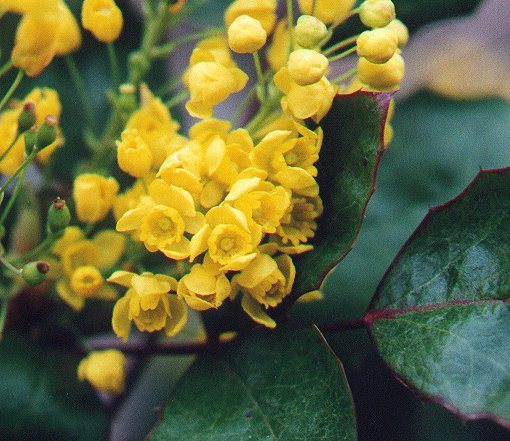

Mahonia aquifolia
Mahonia holly is an evergreen that grows in western parts of North America. The shrub grows up to one and a half meters and has large leathery leaves. Leaves are pinnate and consist of several spiny-toothed leaves. In the process of blooming, they have a reddish tint, in summer they are dark green, and in autumn they are golden-bronze, especially if the plant grows in sunny areas. Mahonia flowers are yellow and grow in inflorescences, which are located at the ends of the shoots. Magonia blooms in early May and continues to bloom throughout the month. Sometimes it blooms again in October. The plant bears fruit of an oblong-elliptical shape with berries that have a dark blue bloom. The berries are edible and have a pleasant sweet and sour taste. The berries ripen in early August and give the plant a very unusual look. Mahonia is a cross-pollinated plant. A single bush does not have fruits, therefore it is customary to plant Mahonia at least in pairs. Plant productivity depends on successful pollination. If all conditions have been created for pollination, then Mahonia will delight you with its fruits. But the main purpose of Mahonia is its decorative effect.
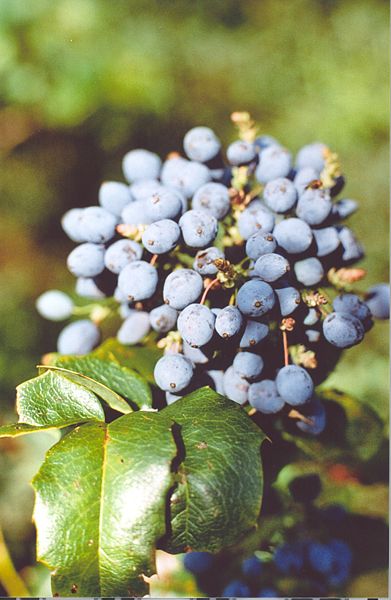

Mahonia bushes give abundant root suckers, with the help of which beautiful thickets are formed near the bush. The plant tolerates shade well, and forms beautiful and dense bushes in sunny areas. Grows well in humus-rich soil, tolerates urban conditions and crown pruning well.
Winter care
In central Russia, there is conflicting information about the winter hardiness of Mahonia. And it is no coincidence. The natural habitat of Mahonia is North America, and plants grow in an area stretching from north to south. Those species that grow along the southern mountain ranges of the mainland in Russia do not withstand the winter cold and most often freeze. And the plants that grow in the northern part have satisfactory winter-hardy characteristics. These facts were confirmed by experts from the main botanical garden. However, in plants growing in the north and south, there are practically no external differences. To this we must add that the resistance of a plant depends on its age. Young Mahonia bushes freeze slightly more often than bushes that are three or more years old. Therefore, when planting low-winter forms, they must be covered for the first two winters. For winter shelter, spruce branches or fallen leaves are used, preferably oak leaves. On top of the shelter, it is necessary to lay a film or non-woven material.
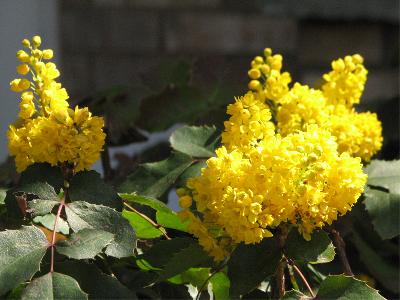

Decorativeness
Magonia has a decorative appearance throughout the year, but it is especially beautiful in spring, when most of the plants have not yet appeared leaves, and young shiny leaves with a reddish tint are already beginning to peep out against the background of last year's leaves. Abundant yellow inflorescences during the flowering period look very beautiful together with shiny leaves. And with abundant fruiting, the Mahonia bush looks very impressive. Mahonia bushes look equally good both for single and group plantings. Usually gardeners plant it in the foreground or next to rocky hills. Mahonia can also be planted in curbs or low hedges. The plant has been used as an ornamental plant since the 19th century.
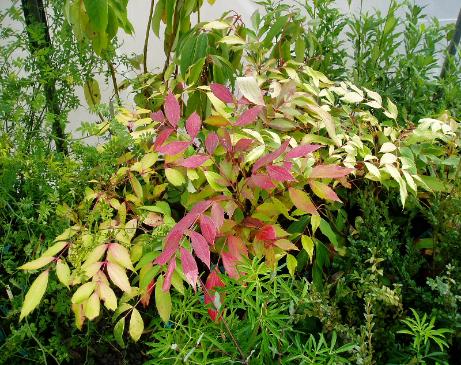

Decorative magonia has several types:
- nut-leaved mahonia (f. Juglandifolia). Its leaves consist of seven leaflets, smaller than that of the main form. The species also has a red petiole of a compound leaf.
mahonia graceful f. Gracilis - with long leaves. Mahonia golden (f. aurea) - with golden leaves Mahonia variegated (f.variegata) - variegated leaves.
The Apollo variety is the most popular in Europe. He was taken to Dutch gardeners in 1973. The plant grows up to 1 meter and has the same crown diameter. The leaves of this variety are complex and grow up to 30 cm in length. They consist of 5 or 7 leaves with sharp teeth. In summer, the leaves of the plant are dark green, and in August they acquire a bronze tint. Blooms in May. The flowers are up to 0.8 cm in diameter, are bright yellow and have a pleasant smell. The berries are bluish-black in color and ripen in August.
The Atropurpurea variety was also bred in Holland, only in 1915. The height of the bush and the diameter of the crown is 0.6 m. The leaves grow up to 25 cm long and have a dark green color. The flowers reach a diameter of 0.8 cm and are yellow. Fragrant flowers bloom in May. The fruits of this variety of Mahonia are small and bluish-black. The berries ripen in August.
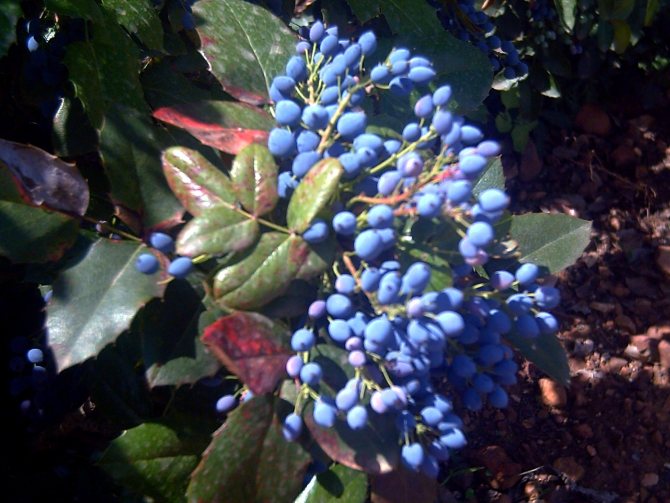

Among the varieties, there is a hybrid of Mahonia holly and common barberry. This shrub is always green and grows up to one meter in height. The leaves of this species have an ovoid-oblong shape. They grow in length up to seven centimeters. The leaves themselves are hard, serrate, and round at the base. The plant looks like a barberry in the form of simple leaves, and with mahonia it is united by the absence of thorns on the shoots and the next arrangement of leaves.
Planting plants
Magonia is planted in open sunny areas. The plant can easily withstand slight darkening. The growth of the plant is slow. The plant prefers fertile, loose soil. The soil mixture should consist of humus, turf and sand in a 2: 1: 1 ratio. Mahonia bushes grow worse on compacted soil. On dry soil, the plant is more often damaged by frost. If Mahonia is planted on heavy or clay soil, then it needs a drainage layer of 25 centimeters.
When planting Mahonia, it is necessary to take into account the distance between the bushes. In dense soil, the distance should be 1 meter, and in loose soil - 2 meters. The plant can be transplanted at any age. Mahonia does not tolerate a transplant, which is carried out in late autumn. Planting depth should be 50 cm.The root collar should
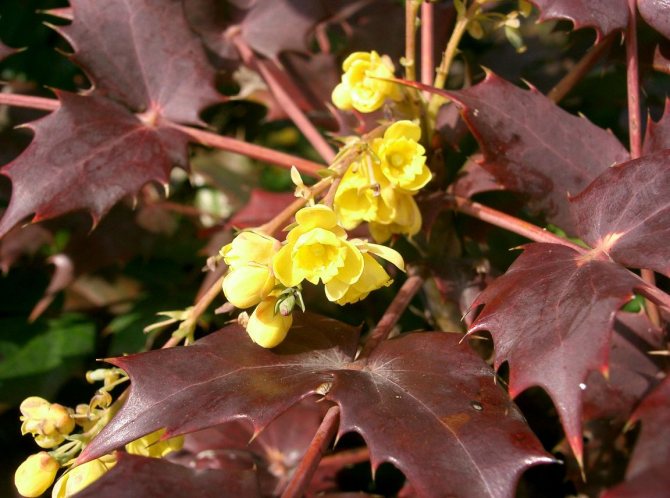

be at ground level.
Mahonia holly - care
Magonia needs regular feeding, which is done twice a season. The first feeding is done in early spring, preferably before flowering. For feeding, keira is used - a station wagon or nitro - ammofoska in a proportion of 120 gr. per 1 square meter. Mahonia grows well in moist soil. Watering is not required under normal seasonal rainfall. However, in dry summers, the bushes are watered once every two weeks. Each bush consumes 10 liters of water. If the soil is dense, shallow loosening is performed. After the spring planting, mulching is not at all necessary, but in the fall, it is advisable to cover the Mahonia bushes with dry leaves or spruce branches. Mahonia bushes are generally not tall and therefore are not usually pruned. And in order for the bushes to be thick, they are simply trimmed almost immediately after flowering. As a last resort, pruning can be postponed to the fall. But it must be remembered that flowers are formed on the shoots of the last year, so they are not cut by more than half, otherwise flowering can be artificially slowed down. Mahonia bushes tolerate rejuvenating pruning easily and recover very quickly. If damaged, the bush can form a dense growth at the base of the bush.
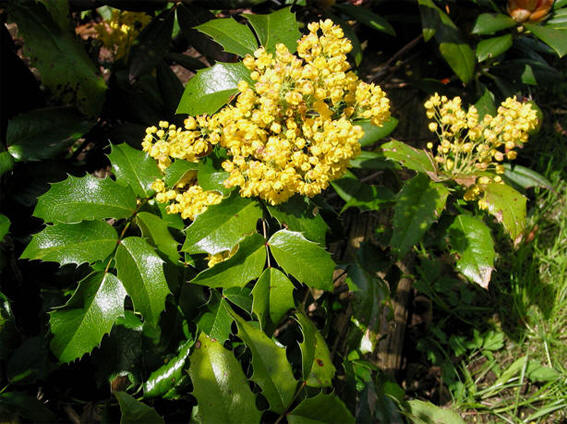

Diseases
Magonia is usually damaged by spotting. To prevent this disease, plant bushes are sprayed with preparations containing copper. For example, 200 gr. green soap and 20 gr. copper sulfate is diluted in 10 liters of water.Also, the plant can be treated with polycarbacin, zineb or Bordeaux liquid. Also, the plant is susceptible to a disease called "powdery mildew". From this disease, Mahonia bushes are sprayed throughout the summer, once every 10 days with the following preparations: Topsin-M, Foundation and or Caratan. Mahonia is also susceptible to rust. To avoid rust, Mahonia is sprayed with zineb or any preparations containing sulfur. One of the main reasons for the limited planting of Mahonia bushes is that this plant, like barberry, is an intermediate carrier of rust fungi, which mainly affect cereals. But at present, experience shows that such a role for the bushes of Mahonia and barberry is clearly exaggerated.
Mahonia propagates by seed, grafting and layering. The best time for seed reproduction is in the fall, right after harvest. You can also sow seeds in the fall, after keeping the seeds at a temperature of 0 to +5 degrees. At first, the shoots of Mahonia must be shaded. The first flowering of seedlings comes on
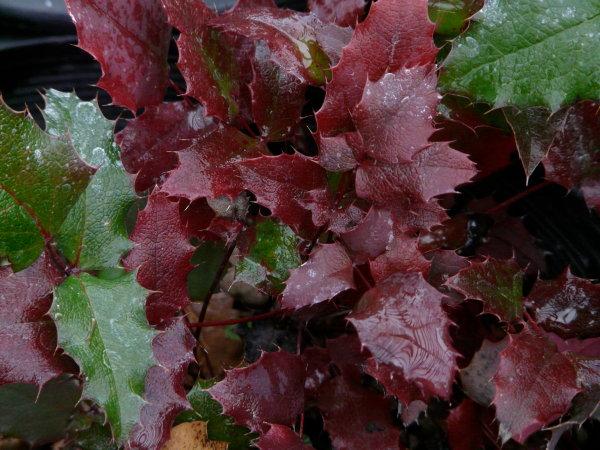

fourth year of life. Such shrubs usually do not have root growth. Mahonia can also be propagated by green cuttings, but subject to artificial fog conditions. In addition to this condition for cuttings, it is necessary to use young plants. Cuttings of old plants practically do not take root.
Mahonia is an ornamental plant and always attracts special attention of florists. It is often used to create winter bouquets. To preserve the branches for a long time, they are usually covered with hairspray.
Landscape use
Magonia looks beautiful among stones or planted in groups on lawns or near the walls of houses. It looks especially beautiful against the background of trees, in the borders. The plant is often planted as a hedge. Mahonia also makes an excellent backdrop for other ornamental plants. A very successful combination is the combination of magonia with roses. It is very often planted in rose gardens, as it emphasizes the beauty of roses with its dark green leaves. Magonia is also planted between the bushes, and then it becomes a beautiful frame for the entire rose garden. Mahonia bushes with Japanese quince and primroses look very impressive. Mahonia has abundant root growth that forms low thickets, and therefore this plant is often grown as a ground cover. Despite the fact that Mahonia is a light-loving plant, it tolerates shading well, therefore an evergreen layer is often formed from the plant, which is covered with a transparent canopy of trees.
The genus unites 50 species, native to Central and North America, East Asia.
Magonia is an evergreen shrub with shiny, pinnate, leathery leaves, sharp-toothed leaves along the edge.
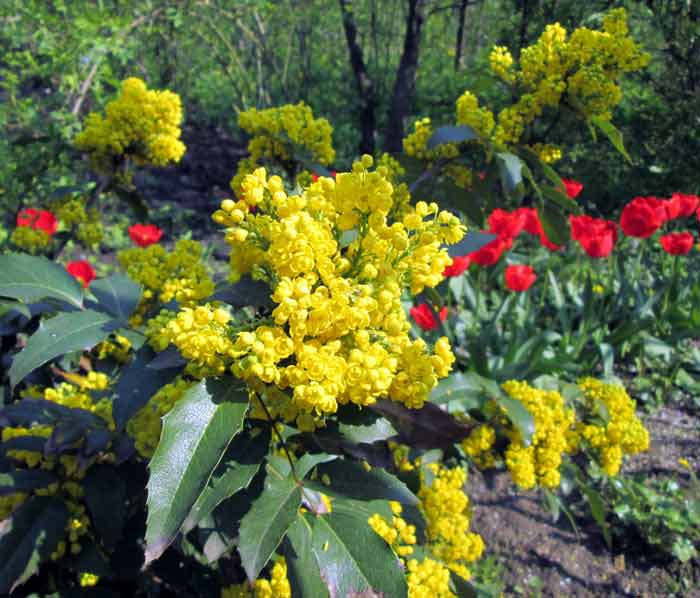

Mahonia flowers are yellow, small, in multi-flowered inflorescences. The fruits of this shrub are blue, with a bluish bloom, very rarely whitish or red, spherical or oval.
Magonia is shade-tolerant, tolerates pruning well, and is resistant to pests. A beautiful plant for forest edges, undersized groups, borders.
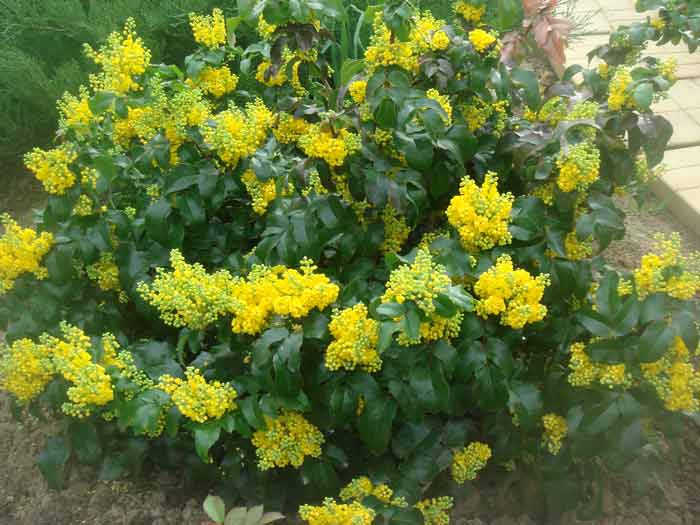

Reproduction of Mahonia holly
There are three ways to propagate holly Mahonia: seeds, root suckers and cuttings.
The best of these is considered vegetative.
However, you need to understand that even this method will not help you quickly and easily landscaping the area. Each of the methods is quite laborious and time consuming, and also requires certain knowledge and skills.
Cuttings
Propagation of Mahonia by holly cuttings is the most common method. In this case, use green undamaged shoots with leaves.
In order to correctly and successfully carry out cuttings, you can use the following tips from florists and gardeners:
- it is necessary to cut the cuttings so that the upper cut is straight, and the lower one is oblique;
- for the fastest development of cuttings, the lower cut can be treated with root growth stimulants;
- large sheets are shortened by half;
- prepared cuttings are placed in pre-prepared soil with a depression to the first lower bud;
- after planting, the cuttings should be watered abundantly, and then covered for faster rooting;
- possible treatment with a fungicide for the prevention of diseases.
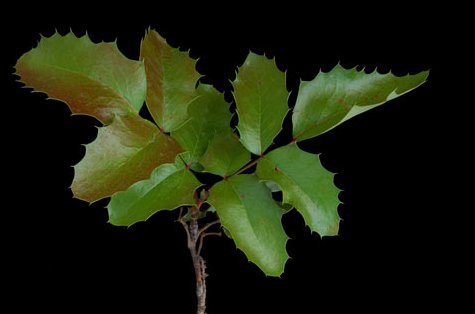

Division of rhizomes
Spring breeding is no less popular Mahonia aquifolium
layering.
To do this, strong shoots are bent to the soil and sprinkled with earth so that the top is above the ground.
In the place of the bend, it is necessary to make a wire constriction, which will facilitate root formation.
While the rooting period lasts, the plant must be watered abundantly and, if necessary, sprinkled with earth. If in the autumn a good root system is formed at the bend, the cuttings are separated from the parent bush and transplanted to a permanent place.
In case the roots are weakened, the cuttings must be left for the next year.
Seed method
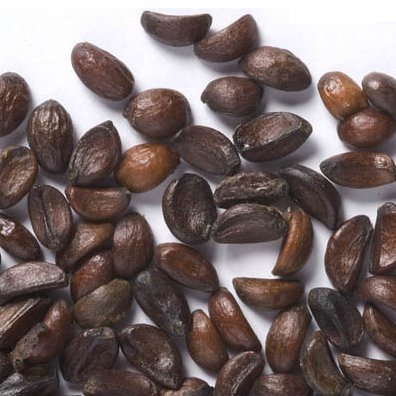

Seed propagation is carried out in spring or autumn, immediately after collecting the seeds. This type of reproduction is quite long: before sowing, the seeds are subject to stratification within 3 months at a temperature of +5 ° C (in the refrigerator).
If seeds are sown in the fall, long before frost, then they will undergo natural stratification. Seeds are sown in grooves to a depth of 1-2 cm.
Another breeding method is possible, which is sometimes advised by experienced Mahonia owners. In winter, several twigs can be placed in jars on a cool, light windowsill.
After a couple of months, roots form on half of them. Try planting them in the spring. According to observations, such plants develop powerful roots, these shrubs grow quickly and have a strong immunity to diseases.
Types and varieties
Mahonia holly
The homeland of Mahonia holly is North America. Under natural conditions, it occurs on overgrown slopes and in forests. Drought-resistant.
Evergreen shrub 1.5 m in height. An interesting shrub, primarily with leathery, large, shiny leaves, 6-9 spiny-toothed leaves; when blooming, they are reddish, in summer they are dark green, in autumn they are red-golden-bronze.
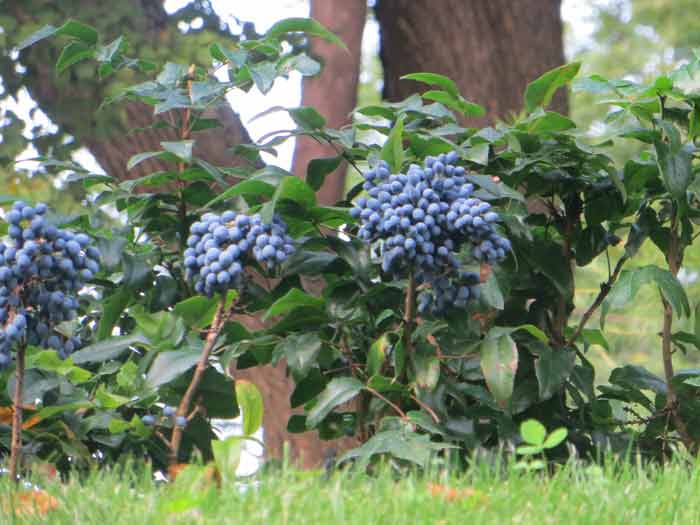

The leaves are shaped like holly foliage. Flowers of Mahonia holly are numerous, yellow, in erect, branched inflorescences at the ends of the shoots. Blooms in May for about a month, sometimes blooms again in October.
The fruits are blue, edible, sour-sweet, ripen in August, giving the bush a certain originality. Mahonia holly is a cross-pollinated plant.
Therefore, gardeners wishing to grow Mahonia as a berry crop should plant at least two bushes. The harvest of Mahonia holly depends on the conditions of pollination.
If the pollination went well, then the bush will be strewn with fruits. However, Mahonia is holly, primarily an ornamental crop, not a berry one.
Mahonia holly gives root suckers, thanks to which low thickets are formed. Forms dense bushes on a sunny location.
Shade-tolerant. This shrub loves humus-rich soils; perfectly tolerates city conditions, crown molding and trimming.
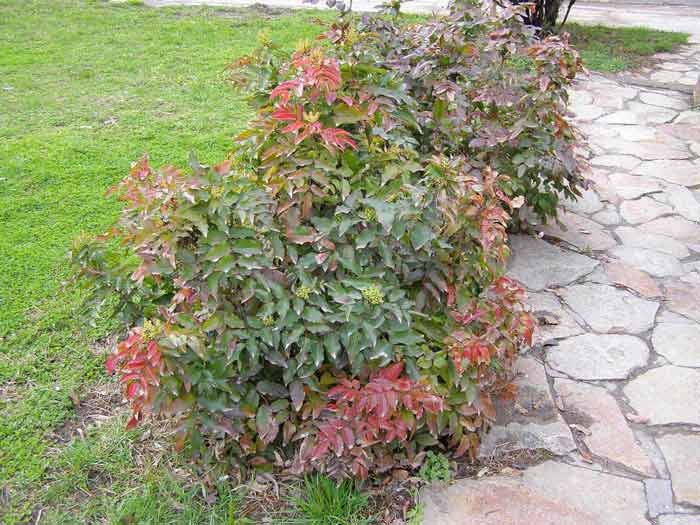

There are conflicting opinions about the winter hardiness of Mahonia holly in Russia in the middle lane. This is no coincidence. Since the natural area of this shrub is stretched from north to south along the western part of the mainland.
Forms, originally from the southern part of the natural range, sometimes freeze in our country. At the same time, plants from the northern part are quite winter-hardy. Also, frost resistance depends on the age of the plant.
Young specimens of Mahonia freeze more often than adult bushes. Therefore, young specimens need to be covered for the winter.To do this, use spruce branches, fallen leaves, on top of which it is necessary to put a film.
Mahonia holly is decorative all year round. It is beautiful in spring, when most of the species have not yet been enveloped in foliage, and reddish, young, shiny leaves are visible in it.
During the flowering period, its yellow inflorescences are perfectly combined with shiny dark leathery foliage. It is also effective at fruiting, decorated with blue fruits.
Looks great in single landings, in curbs, when decorating rocky hills.
Decorative forms of Mahonia: nut-leaved - leaves are denser than those of the typical form; graceful - with long leaves; golden - with golden leaves; variegated - with variegated.
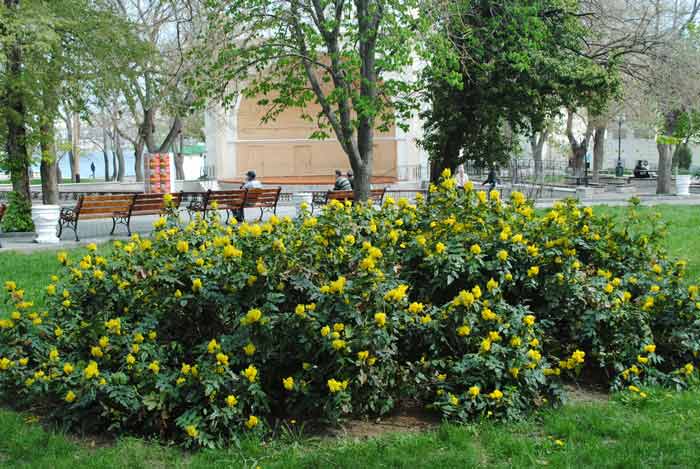

Magonia creeping
Originally Mahonia creeping from North America. In natural conditions, it grows in forests and on slopes. Drought-resistant. Practically unknown in horticultural culture.
In appearance, it differs little from holly, only the height of the bush rarely exceeds 50 cm.The leaves are dull-gray-green, leathery, prickly, sharp-toothed.
Mahonia grows creeping slowly. Blooms from six years old, rarely again in September.
More hardy than holly Mahonia, but less effective.
Shoots of creeping magonia have a high rooting ability. Good as a ground cover shrub in curbs and rocky hills.
In Moscow, it can hibernate in the open field, however, the plant must be sheltered from severe frosts.
Mahonia creeping has decorative forms: round-leaved; large-fruited.
> Location of Mahonia
They are planted in open sunny areas. Put up with a little shading.
> Soil for Mahonia
Prefers fresh, fertile, loose soil. When the soil is compacted, it grows worse. On heavy soils, drainage is required with a layer of 25 cm.
> Landing
You can transplant Mahonia at any age. Poorly tolerates late autumn transplantation.
Views for the middle lane
The following varieties of Mahonia are popular in our area:
- Holly: a bush that reaches a width of one and a half meters, in length - one meter. Differs in prolific root layering.
- Creeping: a creeping shrub that grows up to 45 centimeters. It is used to cover the ground, decorate decorative rocky gardens.
- Japanese: it reaches two meters in height and three in width. The length of the sheet plate is up to 30 centimeters. Has reddish cuttings.
Description of the plant
An evergreen shrub of the Barabaris family has a lot of advantages:
- beautiful due to leathery, shiny, thorny leaves,
- unusual due to the fragrant tassels of yellow flowers,
- you can get a harvest of edible, sour berries,
- bark covered with cracks looks unusual.
Hence there are many names: lily of the valley shrub due to the shape of the flowers, holly grapes for leaves that resemble holly leaves, and berries that look like bunches of grapes. Throughout the year, the shrub looks decorative.
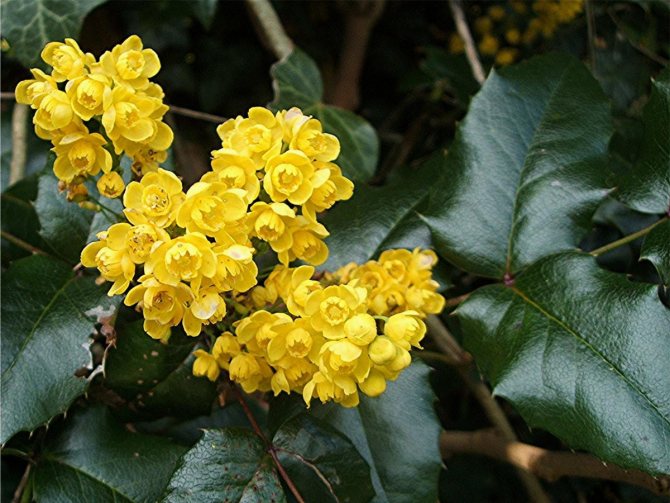

This is interesting: the homeland of Mahonia is the region of East Asia, the Himalayas, North and Central America. It owes its name to Bernard Magon, who created the American garden calendar in 1806.
Mahonia is holly (Oregon grapes) in comparison with its closest relatives, undemanding to growing conditions and cold-hardy. The bush grows more in breadth than upward. Reaching a height of 1 m, it has a width of 1.5 m. It quickly spreads due to root growth. Any conditions are suitable for growth.
In the Moscow region, Mahonia begins to bloom in mid-spring. The berries can be harvested at the end of summer. The flowers are small and yellow, but due to the fact that they are collected in inflorescences, they look decorative. They have a rich aroma. Mahonia tolerates mild return frosts during flowering.
You need to know: The winter hardiness of young plants is slightly exaggerated.Therefore, in the first 4-5 years of life, you will need to cover it with spruce branches for the winter and cover it with snow. Only in this way will she winter well and delight with abundant flowering.
Leaves are compound, collected from about 20 leaflets, each of which has a thorn at the end. The total size of the sheet is 40cm in length. In summer, the leaves are green-gray, and in the autumn-winter period they become bronze or yellow-red. The petioles also acquire a reddish tint.
The berries are dark purple with a bluish bloom, sour in taste, very rich in vitamin C. They create an exotic contrast: they look unusual against the background of bronze leaves. And they are also used to prepare wine, compotes, and jam.
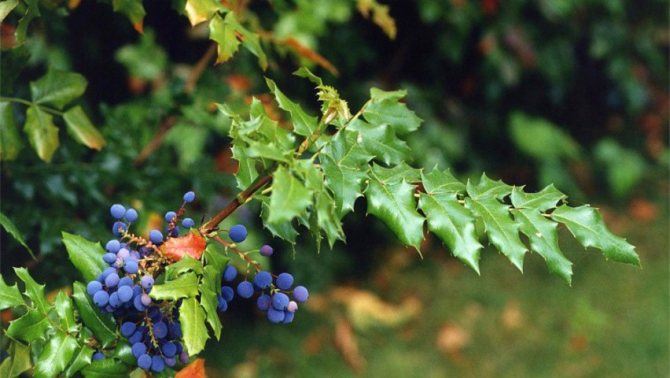

The roots contain berberine, a substance that is used in medicine due to its antibacterial properties. Recent developments by scientists have revealed the ability of this compound to stop the development of tumors. It is also used in the preparation of bitter tonics.
The best varieties of this species include Apollo and Compasta. Mahonia holly Appolo, a photo of which you can see just below in the gallery, is characterized by lush flowering, compact crown and slow growth.
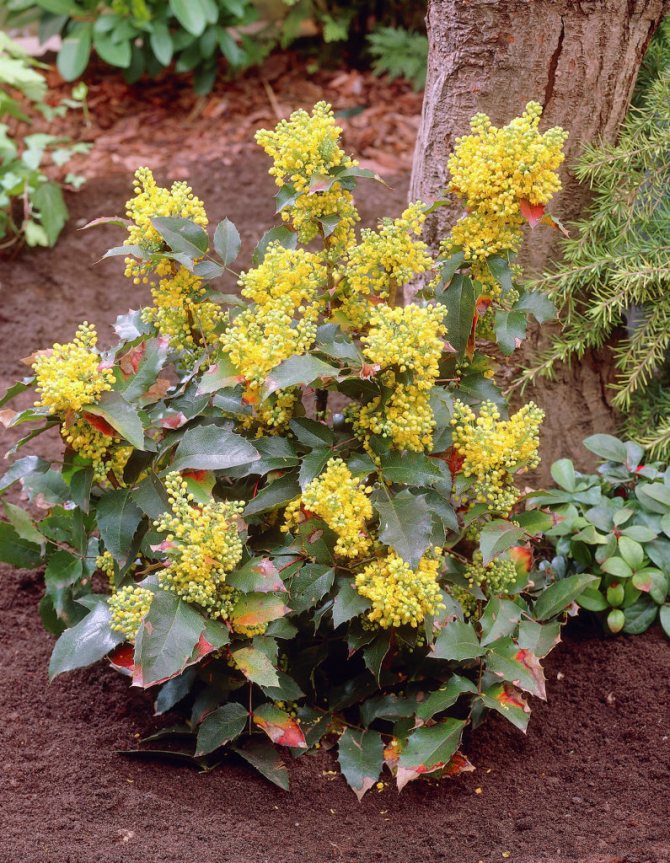

Mahonia aquifolium - Mahonia Apollo
Application in traditional medicine
- To restore the body and improve overall well-being after chemotherapy, use the following tincture: Rinse fresh berries under running water and dry, then pour into a glass container. Pour the raw material with 60% alcohol in a 1: 1.5 ratio. Insist the mixture for 2 months in places where sunlight does not enter. The finished product has a rather specific taste, so it can be diluted with water or added in small amounts to other tinctures or drinks. To prevent the development of new tumors, you can drink alcoholic infusion from poppy seeds.
- To improve appetite and metabolism, as well as to improve overall body tone, drink tea based on American barberry root. To do this, take 1-2 tsp. chopped root, mix it with 1 stack. clean water and simmer for 5 minutes. Leave the finished drink under the closed lid until it cools completely. Filter the cooled tea and drink in small portions before each meal.
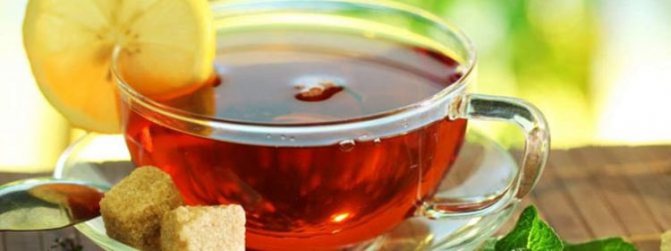

- For gout, use the following medicine: 1 spoon of dried bush flowers is poured with boiling water (250 ml) and insisted for 1 hour. Then the product is filtered through cheesecloth or a sieve and 50-70 ml is drunk 2 or 3 times a day.
- In the presence of skin diseases, wounds or ulcers, use an infusion from the bark: Place the chopped bark in a glass container and fill it with vodka or alcohol. The ratio of raw materials and alcohol component should be 1:10. Insist the remedy for 30 days, then take 10-15 drops once a day. Also, macadamia oil can be used as an additional remedy to fight inflammation on the skin.
How to plant correctly?
The shrub is undemanding to soil conditions. This is due to the fact that the root system lies deep and can independently extract nutrients and moisture. But it is better if it is fertile, slightly acidic and well-drained soil. Stagnant water and alkaline soils are not for her.
Loves the sun, but can grow in partial shade. If you plan to create a hedge, then it is better to choose an open place: here the bushes will be thicker and lush. You can plant shrubs in groups.
It is important to know: Under natural conditions, Mahonia grows in light partial shade. Therefore, the bright sun can cause burns on the leaves. Strong wind and shrubs are adversely affected.
Landings create:
- for landscaping lawns and squares,
- along streets and highways (tolerates polluted air well),
- like a hedge or a low curb on a garden plot.
In a word, the "unusual beauty" is gorgeous everywhere. It propagates by seeds, cuttings, root shoots, dividing the bush.Since the root growth of Mahonia forms a lot, we use it for reproduction. Landing involves the following actions:
- Choose an open area with light, well-drained soil.
- We are waiting for warm spring days so that the bush will take root well over the summer.
- We plant in planting holes 50 cm deep, without deepening the root collar.
- We maintain a distance of up to a meter between the plants. If we create a hedge, then half a meter will be enough.
- We water the soil, lightly tamp, mulch.
Gradually, the red-purple bush will grow, but it grows for a long time, growing well in breadth. Therefore, forming pruning may be needed.
Outdoor planting
In order for Mahonia to take root and bear fruit, planting in open ground must be done according to all the rules. The choice of location also plays an important role.
Timing, location, soil
Landing is carried out from the beginning of spring, when the snow completely melts, and until the end of autumn. The most favorable time is considered to be March 1-15.
The plant grows well in open and sunny areas. However, he needs a small partial shade for several hours a day. Therefore, it is good if tall trees are located nearby, blocking the sun. The place must be selected protected from drafts and strong gusts of wind.
A lot of shade has a bad effect on Mahonia: the fruits become worse, their number decreases. Prolonged exposure to direct sunlight burns the greenery of the tree.
It takes root in any soil. But young specimens are best transplanted into soil with a large amount of humus. The planting hole is covered with a mixture of turf and humus in a ratio of 1 to 2.
Rules, step-by-step description of planting magonia
Disembarkation is carried out as follows:
- Prepare a hole for a seedling 3 times the size of the rhizome. The depth of the hole is 50-60 centimeters.
- Fill the bottom of the pit with a mixture of humus, garden soil and sand.
- Place the seedling in the hole in an upright position. When the rhizome is closed, it is important not to destroy the earthen lump. With the layering open, straighten it.
- Sprinkle the pit with the rest of the soil, without tamping it hard.
- Water, making sure that the ground remains airy.
- Mulch the trunk circle.
- After watering when the soil dries.
Rules to follow when boarding:
- The neck of the seedling is at the same level as before planting, or two to three centimeters lower.
- If water accumulates at the landing site, a drainage layer is necessary: pour pieces of brick or rubble eight to ten centimeters into the bottom of the hole. This will prevent decay of the root system, improve the vegetative process.
- When plants are grown in groups, the distance between them should be at least one meter.
Mahonia quickly takes root in the open field. If the landing was carried out according to all the rules and recommendations, further care does not cause much trouble. The transplant does not bring discomfort to the plant.
It is recommended to fertilize the plant at least twice a season. The first feeding is carried out in early spring. Mixtures with nitrogen are used. Such fertilizers promote rapid and abundant leaf growth. The second time is fed during the flowering period. Complex mineral fertilizers are used.


Magonia tolerates it well. But you can't cut the branches too short: the plant will stop producing buds. You can form a plant after flowering. Branches with ovaries should not be cut off; fruits will appear from them. Flower buds appear only on two-year-old branches. To harvest the next year, they can be cut in half.
Reproduction
The plant is bred with cuttings, root shoots or layering, seeds. The latter option is less popular due to its complexity:
- the need for stratification (preliminary soaking of seeds);
- most specimens are hybrid: the likelihood of varietal is minimized;
- seedlings germinate for a long time;
- flowering only three years after planting.
With the other three breeding methods, these difficulties are absent. Step-by-step breeding of Mahonia cuttings:
- Semi-freshened material is cut with 6-8 buds in spring or autumn.
- Cuttings are treated with Kornevin, placed in the soil two buds deep.
- The root system should be warm and the tip moderately cool. Often a container with seedlings is placed near the battery, the greens are above the level of the windowsill.
Layers need to be pinned to the ground in the spring. They are separated from the mother plant in the fall. The emergence rate of high-quality seedlings is higher than with cuttings. Roots are also an excellent breeding material.
Care, cultivation
Magonia requires minimal maintenance, so enjoy the magnificent appearance of the "overseas beauty" without much hassle and stock up on berries rich in vitamins. Let's say a few words about the most necessary activities:
- Regular watering and mulching is required to retain moisture.
- Mahonia loves sprinkling (spraying over the leaves) and foliar dressing, recommended once a month.
- Pruning begins when the plant is 10 years old. It gives the bushes a compact and well-groomed look. It is carried out in the spring before the onset of sap flow. The shrub tolerates pruning and shaping well.
- The first feeding with complex fertilizer is carried out in the spring, scattering it at the base of the bush.
- Pests do not like its leathery leaves; it gets sick under adverse environmental conditions. Mahonia is affected by the most common fungal infections that can be destroyed by targeted fungicides.
Attention! In order for brushes of berries to appear on Mahonia, several specimens must be planted on the site, since the plant is cross-pollinated.
Mahonia Atropurpurea
Care for Mahonia, how to properly grow an ornamental shrub
Caring for the shrub will not present any particular difficulties. So, in the spring, you just need to weed the soil under the bushes, feed with a small amount of minerals and fertilizers.
In dry summers, the shrub must be watered. If the summer season is rainy, then you can do without watering altogether. Autumn care involves mulching the soil and covering the plant with spruce branches.
Pruning do only for decorative purposes. It should be as gentle as possible - the shoots should be cut off no shorter than half, so as not to weaken the flowering. This is usually done immediately after flowering.
When and how to water the plant
The soil indicators under the bush must be monitored. If the summer is very hot and dry, then it must be watered.
Important! Watering is carried out at the rate of one bucket of water per plant 1-2 times a week.
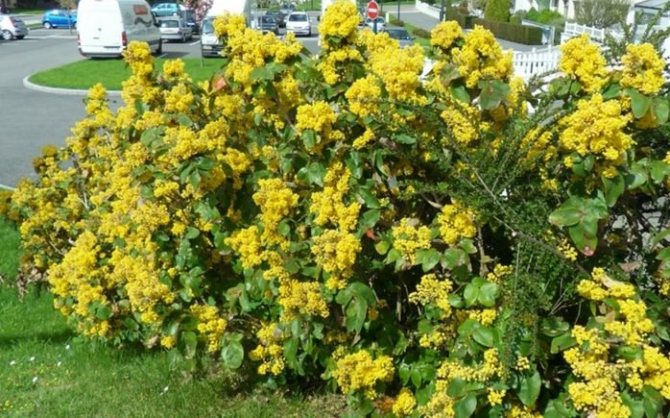

Don't overdo it
because stagnant moisture will be unpleasant for the plant. It can be watered either under the root or with a hose and a diffuser.
After watering, loosen the soil, this will allow air to additionally flow to the root system, and excess moisture to evaporate.
Features of feeding Mahonia holly
Fertilizing Mahonia is enough twice a season. The first feeding is carried out immediately after the snow melts. For this, fertilizers "Kemira universal" or "Nitroammofosku" are used at the rate of 100-120 g per square meter.
The second feeding is carried out in May, before the flowering of the shrub. "Nitroammofosku" is used in the same volume.
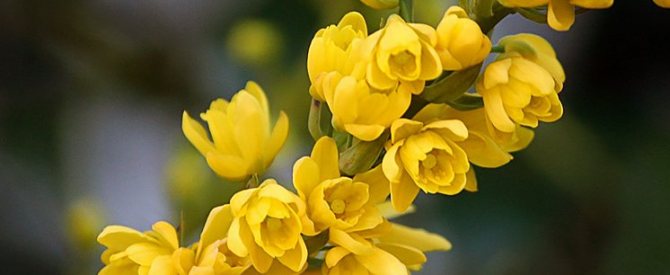

Soil care
The land where Mahonia grows does not require special care. Shallow loosening of the soil is carried out only after watering and when it hardens.
When loosening, try to be very careful, you should not loosen deeply. Mulching after planting in the spring can be omitted, it should be mandatory in the fall.
Varieties for the Moscow region
Types and varieties of Mahonia are distinguished by excellent decorative qualities.
- The already well-known Apollo and the new Smaragd are distinguished by their bright yellow, fluffy inflorescences. The Appolo variety was bred in Holland.In harsh winters, foliage can fall off, but then it quickly recovers. Berries of this variety are used to make wines.
- Atropurpurea (that is, red-leaved) is interesting for its autumn, dark red foliage. Dome-shaped small shrub. The berries are black with a blue bloom. Grows well in partial shade.
- Aurea has an unusual golden foliage;
Magonia Aurea - Gracilis: graceful due to graceful, elongated leaves;
- Jaglandifolia, whose leaves are very similar to walnut leaves.
Although the variety is not so great, these varieties endure the climate near Moscow and can surprise the inhabitants of the middle lane with their unusual beauty. You can see how they look in garden design in the photo below. Spectacular Mahonia Blossom Border:
For your information: There is a hybrid of Mahonia holly and common barberry - Newbert's magobarberry. This beautiful evergreen shrub bears similarities to barberry and Mahonia.
What do they eat Mahonia with?
An exquisite native of North America - Mahonia aquifolium - was introduced to Europe in the 19th century and immediately gained well-deserved popularity. For what? Judge for yourself!
Magonia is an unpretentious but very beautiful evergreen shrub
If you want to plant a magnificent evergreen shrub in your garden - feel free to plant Mahonia! In Russia, this plant is considered to be decorative, and not everyone knows that its berries are edible and have a pleasant dessert taste. So, having admired enough bunches of dark blue berries, you can indulge yourself and feast on them. Remaining on the bush, they do not lose their original taste and useful properties for 4-5 months.
Mahonia berries are both beautiful and quite tasty. Photo from the site
Beautiful and leathery shiny leaves with tiny sharp needles along the carved edges. In summer they are deep green, and in winter almost all turn brownish-purple, up to a purple hue.
Sharp thorns give the leaves of Mahonia a special charm. Photo from the site pitomnik-
Magonia in landscape design
The "exotic beauty" mahonia is widely used in landscape architecture. And there is every reason for this:
- Mahonia can be planted in any corner or area of the garden. It will look great everywhere.
- Can be used as a second tier when planting hedges such as conifers. In the shade of their crowns it will look great.
- With undersized flowers and shrubs, it also looks very original. For example, among heather species, creeping juniper, rose bushes. Nice surrounded by chrysanthemums, dicenter, heuchera.
- It is easy to combine it with any flora of the site. The main thing is to show imagination and magonia will sparkle with new colors.
- By creating unusual landscape compositions with the help of this shrub, you will emphasize the individuality of your site.
- A living wall or border will add a unique flavor to the path along which it is planted.
- Given its ability to grow well in a city, Mahonia will decorate parks, squares, alleys, recreation areas.
This is a wonderful plant worth paying close attention to. And given the biological characteristics, even the most experienced gardener can grow this culture. This is another "overseas miracle" that will help paint our lives with bright colors.
Mahonia holly berries application
Mahonia infusions
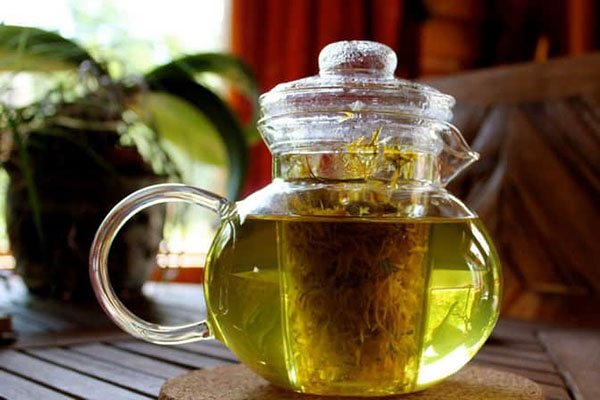

Holly tincture prepared on the bark of Mahonia saves from diarrhea and dyspepsia, cures rheumatism, gout and kidneys. It is also used for liver and gallbladder pathologies. It is not difficult to prepare such a medicinal potion.
Here are the basic rules:
- The bark of magonia needs to be crushed, poured with vodka in a ratio of 1:10.
- Before taking the infusion of Mahonia holly, keep the mixture in a dark place for 7 days.
- For all of the above diseases, drink the tincture in 5-15 drops, adding it to the water.
The tincture of the flowers of the plant possesses medicinal qualities.She copes well with gout. To prepare it, pour a teaspoon of opened buds with 1.5 cups of boiling water. When the broth has cooled, strain it and take 1/3 cup three times a day before meals.
Pests and diseases
The plant is rarely affected by insects and diseases. Sometimes on Mahonia appear:
- Powdery mildew. White spots appear on the upper part of the leaf plate, which eventually pass to the entire aerial part. If you examine the plant more carefully, you can see cobwebs, cotton balls. Powdery mildew spoils the appearance of Mahonia, but does not lead to its death. You can get rid of the disease by spraying with Fundazol, Topsin-M, Karatan. The manipulation is performed once a day for 10-12 days.
- Rust. Pustules of different sizes and shapes are formed. If the formations are damaged, a “rusty” powder with fungal spores appears from them. Fungicide solutions help from pathology: Tsineb, Abiga-Peak, Bayleton, Oksikhom.
- Phylostictosis is a fungal infection that causes large spots to form on foliage. Pycnidia appear at the top of the plaques. During the season, the fungus gives several generations. The plant loses its decorative appearance. The foliage falls ahead of time. Flowering and fertility are impaired. For disposal in the spring, collect and destroy the affected leaves. Mahonia itself is treated with Oxyhom, Kaptan or Phtalan before the start of sap flow.
- Stagonosporosis. It is characterized by the appearance of oval spots with a border along the edges of the leaf plates. On top of them, pycnidia of a round shape are formed. Magonia withers and dies. The treatment is the same as for phyllostictosis.
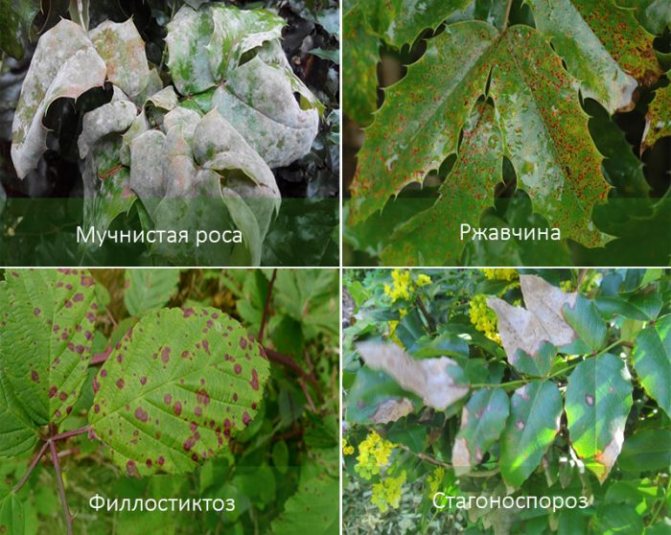

When and how it blooms
The flowers of Mahonia are small, bisexual, collected in fluffy panicle inflorescences. Inflorescences are formed in the leaf axils. The flower consists of 9 sepals and 6 stamens. The shape of the flowers is round, regular, the petals are arranged in two circles.
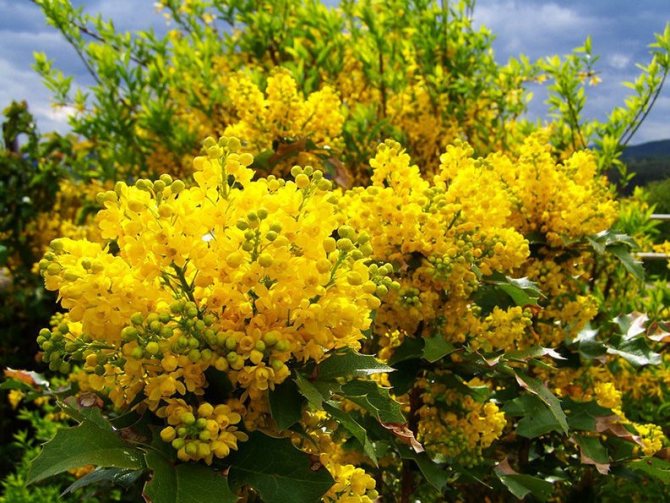

Flowering plant
The flowering period depends on the variety, most often it occurs in May-early June. Some hesitation is possible. Duration is about a month. No care changes are required during the flowering period.
Most popular varieties with gardeners
Rose Chippendale - characteristics of varietal shrub
Some plant varieties enjoy the special disposition of flower growers. They are most commonly found in gardens.
Magonia Apollo
This variety was bred in the Netherlands in 1973. It is a compact bush with a height of about 60-100 cm. The leaves are long, up to 30 cm. Each leaf consists of 5-7 parts. Leaves change color from green to burgundy by autumn. The flowers are bright yellow, fragrant. The berries are dark blue with a waxy bloom.
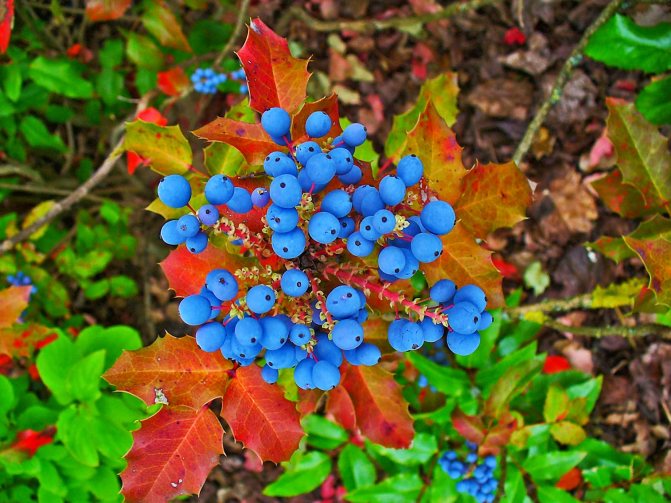

Apollo Berries
Magonia Atropurpurea (Autropurpurea)
The variety is also bred by Dutch breeders. The bushes are compact, the height and width are approximately the same - about 60 cm. The leaves are dark green, glossy, about 25 cm. The flowers are bright yellow, the berries are dark blue.
Magonia Smaragd
Sprawling variety, up to 1 m wide and the same in height. The leaves are pinnate, compound. Dark berries are edible and are actively used in the confectionery art.


